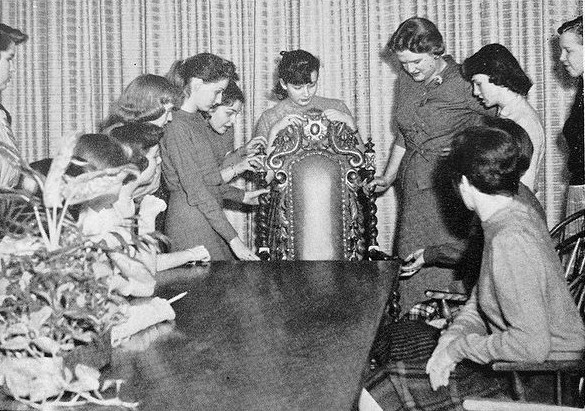Students and teachers describe experiences in classes with gender imbalances
Acknowledging students who identify with the minority gender in a class may be the necessary step towards reducing the gap in classes.

An interior design elective class meets in 1958. Seemingly all-female, the class examines furniture in the photo shown above.
Historically, some choice electives and other non-core classes at New Trier have experienced a large gender gap among students. Over the years, though gender gaps have shrunk, many students and teachers say that there is still room for improvement.
Junior Luke Peebler, enrolled in the Integrated Global Studies School (IGSS), says that the gender skew in his IGSS class was “absolutely” apparent to him, even in the beginning of the year.
“I noticed as more and more people walked into class, that I wasn’t seeing a lot of guys,” said Peebler. According to Peebler, female-identifying students outnumber male-identifying students in his class by a factor of four to one.
Junior Neela Chandraraj, a female-identifying student enrolled in the class Automotives 1, said that she is one of three female students in the elective– a razor-thin minority of the students. According to data provided from Assistant Superintendent for Curriculum and Instruction Peter Tragos, there are 11 girls and 66 boys enrolled in Automotives classes.
According to Chandraraj, “The gender skew was really obvious when I walked in, because everybody was packed together, and I thought I definitely stood out.”
Both Chandraraj and Peebler agreed that the gender skew was a consideration they had before registering for their classes. But Chandraraj was judged for her elective choice as well.
“My advisor made it very clear to me that she never had a female advisee apply to Automotives before, and that it was a big deal. I didn’t need the commentary, because I didn’t really care, but I was a little frustrated that she was so correct in her assumption that there were going to be so few girls in the class.”
Junior Erin Lee is enrolled in an AP Computer Science class, where there are 18 male students and four female students. “I did expect a bit of a gender skew, but I didn’t expect this much of it either,” said Lee.
Lee says she hasn’t let the scarcity of girls affect her class performance. However, Lee noticed that the skew in her class could be following a pattern.
“I’ve generally noticed that in STEM classes such as engineering or computer science, there is a very visible gender skew,” Lee said. “You see [a gender skew] for the first time and it could be a little unexpected, but after a while, you stop noticing the skew as much.”
On the contrary, one student who asked to remain anonymous said her experience as the only female-identifying student in Strength and Conditioning class this fall greatly tested her patience.
According to the student, in one incident, “I went to grab a dumbbell and do my exercises, and from around me, I heard boys whispering, ‘Why is there a girl here? The girl is taking up so much space.’”
“The fear of not being able to be vulnerable and to stand up for myself (against harassment) was so heavy,” said the student. The student said that she eventually went on to enroll in another gym class.
Reflecting on her class experience, the student said, “I think being given gym partners that you stick together with would’ve helped. It immediately gives you someone who you can stay by and get close to, which helps get rid of the isolating feeling that I went through.”
Kinetic Wellness Faculty Kate Kalnes teaches a Strength and Conditioning class.
“When an [uncomfortable] instance happens, that’s a big class reminder of… trying to make a supportive environment for everyone to learn,” Kalnes said. “I think it’s all about trying to set that tone as early as you can, and hoping it sticks.”
Chandraraj said she also experienced a notable level of discomfort due to the gender imbalance in her Automotives class.
“The gender skew generally creates a sense of division, and it’s hard to create a community in the class,” said Chandraraj. “So the environment is very quiet and separated.”
Applied Arts teacher Nathan Silvers says he makes a conscious effort to acknowledge the gender and other identity gaps in his classes.
Silvers said, “I notice the gender gap because it changes the planning of classes, trying to make sure everybody feels comfortable across the board. I’m very conscious of what I’m doing, what I’m saying, and that I’m representing everyone to feel accepted.”
Kinetic Wellness teacher Lawrence Stoegbauer has also made an effort to keep classes gender-neutral in content and instruction– including the Yoga and Self Defense 1 class that he started a number of years ago.
“The class wasn’t written to be [skewed towards one gender], but if that’s the way the class is received, as long as it is giving value to the students, and there are kids taking it, then that’s fine,” said Stoegbauer. “I don’t believe that I teach to one particular group.”
Applied Arts Department Chair and teacher Jason Boumstein says the Applied Arts department intends to bridge the existing gender gaps through assigning unintimidating and inclusive “projects” in class.
Boumstein said, “In all of our courses in Applied Arts, we have found that the gender gap has definitely reduced in size since twenty years ago. That is done through the conscious effort of choosing correct projects, bringing in industry leaders from all different identities to help develop our curriculum to present to students, and breaking down as many barriers as we can to change stereotypes into future ambitions.”
“We have a ways to go, and we’re going to get there because we’re ambitious, and it is a mission and vision of ours to make our courses as equitable to everybody,” said Boumstein.







































